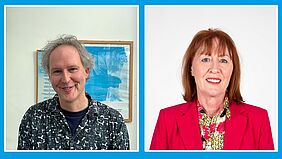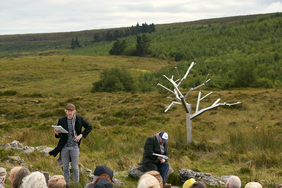The first article reveals the untapped potential of Literary Tourism in an interview with Spot-lit Lead Partner Andy Hallewell (ICBAN) and project communication manager Mary Keaveney (Western Development Commission).
Spot-lit aims to grow the literary tourism sector in the Northern Periphery and Arctic area by supporting organisations and businesses in this culturally-rich region to grow, collaborate, and better engage audiences together.
How did the idea of Spot-lit start?
The Spot-lit story initially began back in 2015, after Ireland celebrated the 150th anniversary of the birth of the Nobel Prize-winning poet William Butler Yeats, one of Ireland’s greatest literary figures.
The Western Development Commission and Irish Central Border Area Network (ICBAN) understood that their shared literary heritage, such as WB Yeats, Samuel Beckett, Oscar Wilde, and Seamus Heaney, were bringing visitors and adding economic benefits to their regions. They began looking beyond their shores to connect with organisations across the NPA territory, where a shared knowledge and learning might emerge that could further develop what is still the relatively untapped potential of Literary Tourism.
The groundwork of the project was made possible by an NPA preparatory project in 2017. The results from the research and market analysis showed that the development of an integrated literary tourism offering would have a positive impact on entrepreneurship and the wider tourism economy across the NPA area.
What is literary tourism and why did you decide to focus on this type of tourism?
Literary tourism is a type of cultural tourism activity motivated by the interest in an author, a literary creation or setting, or the literary heritage of a destination. In more recent times, the literary tourism sector has spilled over to include linkages with creative tourism, such as films. J.K. Rowling’s Harry Potter in Scotland springs to mind. Mythology and oral traditions that are transcribed to literature may also be a source of inspiration for literary tourists. The Finnish epic the Kalevala in the Spot-lit project is an example of this.
Literary tourists are often attracted to a destination as a response to the literature, choosing to visit a location by being inspired by a text that has transformed them from reader to tourist, or from a tourist to a reader. We believe Literary Tourism has the potential to stimulate economies in the NPA area, to enrich communities and overcome cross cultural barriers, something that has never been more important than today, as we consider post-Covid recovery.
What is lacking that the project will provide?
Our research indicated a lack of a coordinated approach to literary tourism development within literary places and destinations. Spot-lit has recently set up a Literary Tourism Network, gathering key literary tourism stakeholders and policymakers across the NPA area. Critically, the group is supported by key players from the Arts & Culture sectors, including the involvement of contemporary published authors such as Carlo Gebbler in Northern Ireland. These writers bring unique and challenging perspectives to the project!
The Literary Business Support Programme has engaged 28 businesses who are developing and marketing new literary tourism experiences across the partner regions. Each partner country is delivering the programme in a format and structure that meets the need of the businesses in that location.
The under-utilisation of digital technologies including social media platforms was resulting in poor international visibility of the range and depth of existing product available. Local promotion was evident but fewer references went on international visitor-facing sites. Through the NPA funding we address this gap by delivering a bespoke business support programme to ensure the enhanced capacity of SMEs to act beyond local markets through increased awareness and enhanced visibility through also the development of digital apps (read more about the Digital Networking Model). The 13 mobile phone apps developed by Kajaani University of Applied Sciences enables Literary tourists to develop their own cross regional literary tourism trails and will provide further awareness and education of literary tourism in the NPA area and encourage transnational awareness across the countries supported in the project.
Through the Literary Tourism Industry Support Programme 4 models for Literary Tourism are under development: Wilde-Things Model – Young People’s Literary Tourism Model – The Wild Atlantic Way Literary Performance Model and The Digital Innovations for growth model.
What is the future of Literary tourism in the NPA?
The place of literary tourism in a future re-imagined post-Covid tourism sector seems stronger, as international visitors re-orientate themselves towards more sustainable, lower impact, and culturally sensitive forms of tourism.
The advent of the ‘staycation’, the desire for families and local people to immerse themselves in the local culture and landscape has become stronger. Respondents to Lapland University’s Literary Tourism survey identified the most important digitisation processes during the pandemic to be digital marketing, online campaigns, and new online stores. Despite huge challenges, the survey reported how Literary Tourism businesses have begun to align themselves with the ‘new tourism’ projected for a post Covid future. They are reshaping themselves towards more small-scale, sustainable and individual tourism that takes in elements of the recreation economy.
Despite the challenges of the pandemic, the future for literary tourism in the NPA has become unexpectedly brighter, and the need for the project’s solutions greater.



